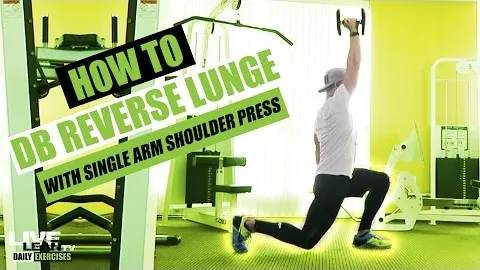
Welcome to our comprehensive guide on the Dumbbell Reverse Lunge with Single Arm Shoulder Press exercise. In this article, we will provide you with detailed instructions, benefits, variations, and safety tips for performing this powerful compound movement. Whether you are a beginner or an experienced fitness enthusiast, incorporating this exercise into your routine can help you strengthen multiple muscle groups and enhance your overall fitness level.
To perform the Dumbbell Reverse Lunge with Single Arm Shoulder Press exercise, follow the step-by-step instructions outlined below:
The Dumbbell Reverse Lunge with Single Arm Shoulder Press is a compound exercise that targets multiple muscle groups simultaneously. Some of the key muscles worked during this exercise include:
Quadriceps: As you perform the reverse lunge, your quadriceps, located in the front of your thighs, are actively engaged to extend your knees and stabilize your lower body.
Glutes: The gluteal muscles, including the gluteus maximus, medius, and minimus, are responsible for hip extension and play a significant role in maintaining balance and stability during the lunge.
Hamstrings: The hamstrings, located on the back of your thighs, act as synergists during the lunge movement, assisting the glutes and quadriceps in hip extension and knee flexion.
Deltoids: The deltoid muscles, specifically the anterior deltoids, are targeted during the shoulder press portion of this exercise. This movement helps develop overall shoulder strength and stability.
Core muscles: The core muscles, including the rectus abdominis, obliques, and transverse abdominis, are engaged throughout the exercise to maintain balance, stability, and proper alignment.
Incorporating the Dumbbell Reverse Lunge with Single Arm Shoulder Press into your fitness routine offers several benefits:
Increased lower body strength: This exercise targets major muscle groups in the lower body, such as the quadriceps, glutes, and hamstrings, helping to improve overall lower body strength and power.
Enhanced stability and balance: The reverse lunge movement requires maintaining proper form and balance, which, over time, improves stability and coordination.
Core activation: The core muscles play an essential role in maintaining proper form and stability during the exercise, resulting in improved core strength and stability.
Upper body strength development: The shoulder press component of this exercise engages the deltoids and other upper body muscles, contributing to overall upper body strength development.
Functional movement pattern: The Dumbbell Reverse Lunge with Single Arm Shoulder Press mimics real-life movement patterns, such as walking and carrying objects. This makes it a functional exercise that can benefit daily activities.
Once you have mastered the basic Dumbbell Reverse Lunge with Single Arm Shoulder Press, you can try incorporating variations to further challenge your muscles and add variety to your workouts. Here are a few variations you can explore:
Dual-arm shoulder press: Instead of performing the exercise with a single arm shoulder press, you can use dumbbells in both hands and press them overhead simultaneously. This variation increases the demands on your core and upper body muscles.
Alternating reverse lunge: Rather than performing the reverse lunge on one side and then switching to the other, you can alternate legs with each repetition. This variation adds more cardiovascular demand and coordination to the exercise.
Front foot elevated reverse lunge: Elevating your front foot on a stable surface, such as a step or weight plate, increases the range of motion and further targets the glutes and quadriceps.
To ensure safety and maximize the benefits of the Dumbbell Reverse Lunge with Single Arm Shoulder Press exercise, keep the following tips in mind:
Proper form is essential: Maintain an upright posture, engage your core, and keep your knee aligned with your toes during the lunge portion. When pressing the dumbbell overhead, make sure your arm is fully extended but avoid locking your elbow.
Start with lighter weights: If you are new to this exercise, begin with lighter dumbbells to focus on perfecting your form before gradually increasing the weight.
Be mindful of your knees: If you have any knee issues or injuries, it is advisable to consult a healthcare professional before attempting this exercise. Modify or avoid the exercise if it causes discomfort or pain.
Warm-up: Always warm up your muscles and joints before performing this or any other exercise. Incorporate dynamic stretches and mobility exercises to prepare your body for the movement.
Gradually increase intensity: As you become more comfortable with this exercise, you can gradually increase the weight and repetitions to continue challenging your muscles and making progress.
The Dumbbell Reverse Lunge with Single Arm Shoulder Press is a compound exercise that offers numerous benefits, including enhanced lower body strength, improved stability and balance, and increased upper body strength. By following proper technique, incorporating variations, and adhering to safety guidelines, you can effectively incorporate this exercise into your fitness routine and take your training to the next level. Remember to listen to your body, start at an appropriate level, and make adjustments as needed to ensure a safe and effective workout experience.
If you're looking for a gym, fitness club or yoga studio, you've come to the right place.
You can find information about gyms in your area. Browse catalog of gyms and find gyms with classes which are you looking for.
On gym page you can find simple information like address, phone or website. You can find list of available classes. You can check availability of personal training or small group classes. On place page you can also see information about open hours.
You can find gyms near you with amenities, courts, studios and equipments.
Use our map to find gym at your city or district.
In Gym Navigator you can find list of exercises with movies for many body parts.
You can browse exercises catalog and find exercises the best of you.
You can also find exercises grouped into workout plans, which you can use to improve you body. Each routine show you exercises one by one and give you possibility to count you progress and count down rest time.